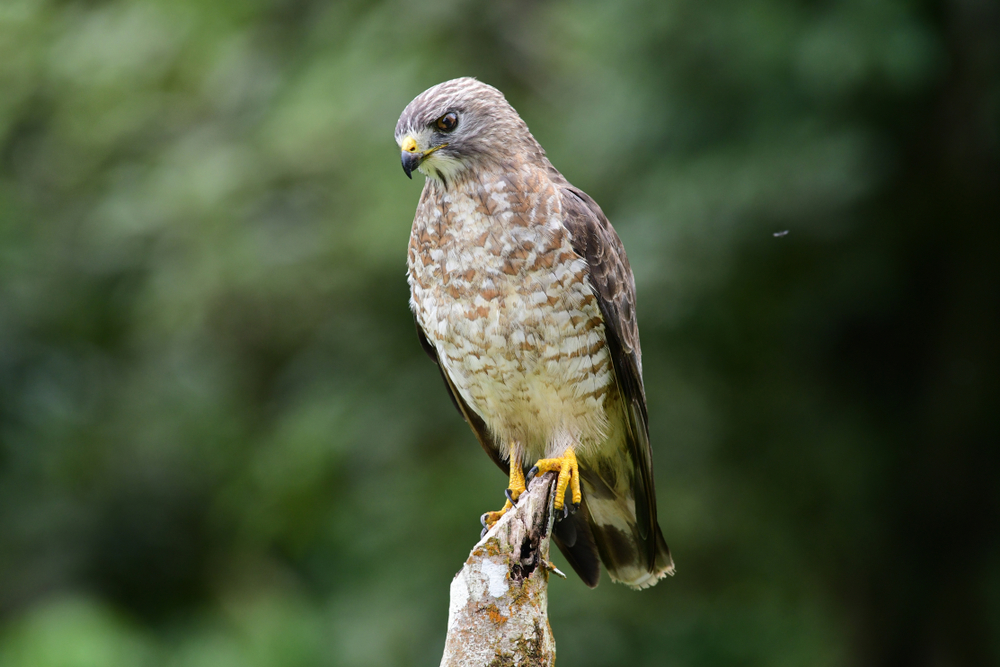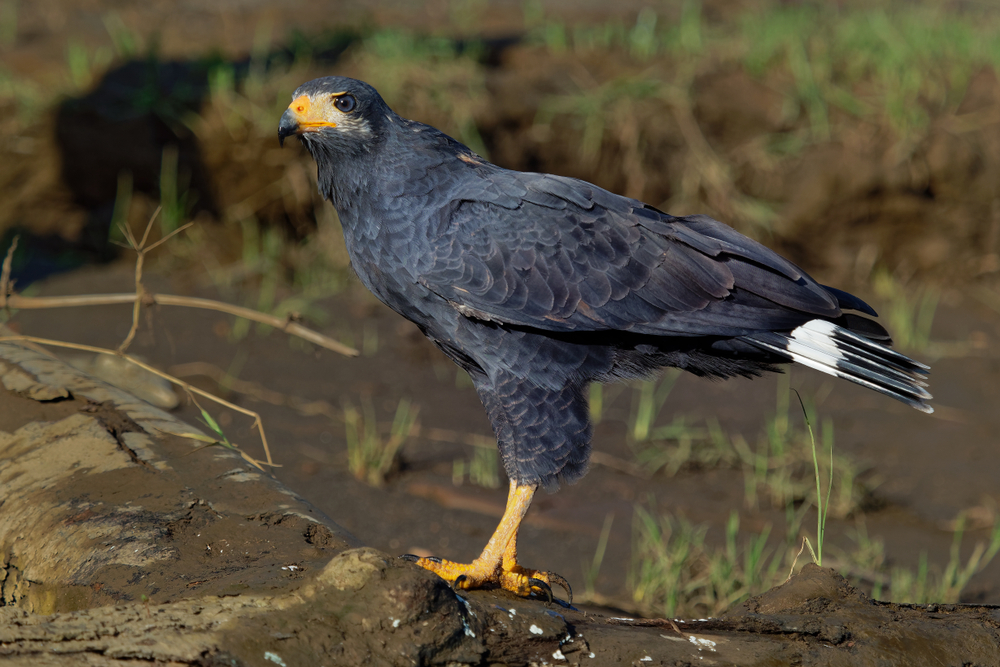The Ferruginous Hawk’s closest relatives are other large Buteo hawks, particularly the Red-tailed Hawk and the Rough-legged Hawk. However, its size, feathered legs, and open-country adaptations make it unique among North American hawks.
About
The Ferruginous Hawk (Buteo regalis) is the largest hawk in North America and a member of the Accipitridae family, admired for its impressive size and striking plumage. Native to the open grasslands, prairies, and deserts of the western United States, Canada, and northern Mexico, it is a raptor perfectly adapted to wide, treeless landscapes where it soars in search of prey.
This hawk measures 56 to 69 centimeters (22 to 27 inches) in length, with an enormous wingspan of 1.3 to 1.5 meters (4.2 to 5 feet) and weighing up to 2 kilograms (4.5 pounds). Its name comes from the rusty, ferruginous tones of its plumage. Two color morphs exist: the light morph, with white underparts and reddish shoulders and legs, and the dark morph, which is much rarer and mostly dark brown. Both display broad wings and feathered legs that extend all the way to the toes, similar to eagles.
The Ferruginous Hawk primarily feeds on small to medium-sized mammals, such as prairie dogs, ground squirrels, and jackrabbits, but it will also take reptiles and birds when available. It hunts either by soaring over open plains or by perching and ambushing prey. Its size, strength, and diet make it an essential predator in North American grassland ecosystems.
Breeding takes place in open country, where pairs build massive stick nests on cliffs, trees, or even on the ground or manmade structures. Females typically lay two to four eggs, and both parents care for the chicks.
Although listed as Least Concern, the species faces pressures from habitat loss, declining prey populations, and human disturbance. Conservation efforts focus on protecting prairie habitats and prey colonies.
With its regal stature, wide wings, and dominance over the prairies, the Ferruginous Hawk is a true symbol of North America’s open landscapes.
Physical Characteristics
The Ferruginous Hawk (Buteo regalis) is the largest North American hawk, recognized for its impressive size, pale coloration, and powerful build.
-
Plumage: Two color morphs exist. The light morph has whitish underparts with rust-colored streaking on the legs and shoulders, and pale underwings with dark trailing edges. The dark morph is mostly dark brown with light markings under the tail and wings. Both morphs feature rust-colored upperparts that give the species its name (“ferruginous” means rust-colored).
-
Face: The head is large and pale with a yellow cere and a sharply hooked bill tipped in black. Eyes are pale yellow to light brown.
-
Body: Broad-shouldered and robust, with a powerful chest and long legs, giving it an eagle-like appearance.
-
Wings: Very long and broad, with pointed tips that make the wings appear triangular in flight.
-
Tail: Long and wide, usually pale with faint banding and a whitish tip.
-
Feet: Strong and feathered all the way to the toes—unique among North American hawks—providing warmth and protection.
Size:
-
Length: About 22 to 27 in (56 to 69 cm).
-
Wingspan: Between 52 to 60 in (132 to 152 cm).
-
Weight: Ranges from 2.2 to 4.6 lbs (1 to 2.1 kg), with females significantly larger than males.
The Ferruginous Hawk’s immense size, rust-colored plumage, and fully feathered legs make it one of the most distinctive and powerful raptors of the open plains and prairies of North America.
Reproduction
The reproductive cycle of the Ferruginous Hawk is closely tied to the open grasslands and prairies of western North America, where nesting sites are widely spaced.
-
Mating and Courtship:
-
Ferruginous Hawks are generally monogamous, often maintaining long-term pair bonds.
-
Courtship displays include soaring flights, dives, and talon-grappling midair. Loud calls and aerial acrobatics reinforce pair bonds.
-
-
Nesting:
-
Nests are built on cliffs, trees, utility poles, rock outcrops, or directly on the ground in open country.
-
Nests are large platforms of sticks, lined with grasses, cow dung, or bones, sometimes reused and refurbished each year.
-
Pairs may build multiple nests within a territory and select one for use.
-
-
Egg Laying and Incubation:
-
Females typically lay 2 to 4 eggs, though clutch size may vary depending on prey availability.
-
Eggs are whitish with brown blotches.
-
Incubation lasts 32 to 36 days, performed mostly by the female while the male provides food.
-
-
Chick Development:
-
Chicks hatch covered in white down and are brooded closely for the first 1–2 weeks.
-
Both parents provide food, with the female feeding chicks while the male delivers prey.
-
-
Fledging and Independence:
-
Young fledge at around 38 to 50 days of age.
-
Juveniles remain near the nest for several weeks, continuing to receive food and honing their hunting skills before dispersing.
-
Ferruginous Hawks’ nesting flexibility—using trees, cliffs, or even the ground—helps them thrive in open prairies, though reproductive success depends heavily on the availability of prey such as prairie dogs and ground squirrels.
Lifespan
The Ferruginous Hawk (Buteo regalis), the largest hawk in North America, lives primarily in open grasslands and prairies where survival depends on prey abundance and environmental conditions.
-
Lifespan in the Wild:
Ferruginous Hawks generally live 8 to 12 years, though some individuals may survive up to 20 years under favorable conditions. As with many raptors, juvenile mortality is high, with many young not surviving their first year due to predation or lack of food. -
Lifespan in Captivity:
In wildlife rehabilitation centers or falconry care, they may live longer, sometimes reaching 20 to 25 years, given regular food supply and protection from natural threats.
Threats to the Ferruginous Hawk:
-
Habitat Loss: Conversion of grasslands to agriculture or urban use reduces hunting and nesting areas.
-
Prey Declines: Populations of prairie dogs, ground squirrels, and jackrabbits strongly influence hawk survival and breeding success.
-
Human Hazards: Collisions with vehicles and powerlines, as well as illegal shooting, remain significant threats.
-
Climate Change: Shifts in prey distribution and extreme weather can reduce food availability and impact breeding.
Conservation efforts, including protection of prairie ecosystems, prairie dog colonies, and large open rangelands, are essential for the long-term survival of this iconic plains raptor.
Eating Habits
Ferruginous Hawks are carnivorous raptors specializing in hunting small to medium-sized mammals across the open plains of North America.
-
Diet:
Their primary prey includes prairie dogs, ground squirrels, rabbits, and jackrabbits. They also take snakes, lizards, birds, and large insects when mammals are scarce. -
Foraging Strategy:
Ferruginous Hawks use several hunting techniques:-
Soaring and scanning over open grasslands.
-
Perch hunting from fence posts or low trees.
-
Ground hunting, where they run after prey—rare behavior among hawks.
-
Occasionally, they hunt cooperatively in pairs around prairie dog towns.
-
-
Hunting Behavior:
They rely on powerful dives and swift glides to overtake prey. Unlike forest hawks, Ferruginous Hawks need open landscapes to use their wide wings and speed effectively. -
Feeding the Young:
Both parents bring prey to the nest, with the female feeding small pieces to chicks until they can tear prey themselves. -
Seasonal Variation:
In breeding season, colonies of ground squirrels and prairie dogs dominate the diet. In winter, they may shift to rabbits, birds, or carrion when live prey is less abundant.
Ferruginous Hawks’ specialization in hunting prairie mammals makes them an essential predator of grassland ecosystems, helping regulate rodent populations. Their ability to hunt on the ground as well as from the air sets them apart from most other hawks.
Uniqueness
The Ferruginous Hawk (Buteo regalis) is North America’s largest hawk and possesses several traits that set it apart from other raptors:
-
Largest North American Hawk: With a wingspan up to 5 ft (1.5 m) and powerful build, it is often mistaken for a small eagle.
-
Feathered Legs: It is the only hawk in North America with fully feathered legs down to the toes, a feature more typical of eagles, providing insulation in cold climates.
-
Color Morphs: Two distinct plumage morphs exist—light morph (pale underparts with rust streaking) and dark morph (mostly dark brown). This variability makes them unique among buteos.
-
Ground Hunting Ability: Unlike most hawks, Ferruginous Hawks are known to hunt on the ground, chasing down prairie dogs or rabbits on foot.
-
Open-country Specialist: Strongly tied to grasslands, prairies, and deserts, they avoid forests and rely on wide-open landscapes for hunting.
-
Prey Dependence: Their populations rise and fall with prairie dog and ground squirrel abundance, showing a strong ecological link to grassland mammal populations.
-
Symbol of the Prairie: With their eagle-like size and regal appearance, they are often considered the embodiment of the North American prairie ecosystem.
The Ferruginous Hawk’s immense size, feathered legs, color variation, and unusual ground-hunting behavior make it one of the most distinctive and iconic raptors of the western plains.
Be the First to Share Photos of This Species.
FAQ’s
1. What is the species closest to the Ferruginous Hawk?
2. How does the Ferruginous Hawk compare to other hawks?
Ferruginous Hawks are the largest hawks in North America, bigger and bulkier than Red-tailed Hawks. Unlike woodland hawks such as Cooper’s or Broad-winged Hawks, they are grassland specialists, often seen soaring over prairies or even running on the ground after prey—behavior unusual for hawks.
3. What national parks provide an opportunity to see the Ferruginous Hawk?
Ferruginous Hawks are found in open prairies and deserts of western North America. National parks where they may be observed include:
-
Badlands National Park (South Dakota) – prairie dog colonies attract them.
-
Theodore Roosevelt National Park (North Dakota) – ideal grassland habitat.
-
Capitol Reef National Park (Utah) – desert and canyon country sightings.
-
Grasslands National Park (Canada) – an important stronghold for prairie raptors.
These parks showcase the open-country habitats essential for the Ferruginous Hawk’s survival.






































































